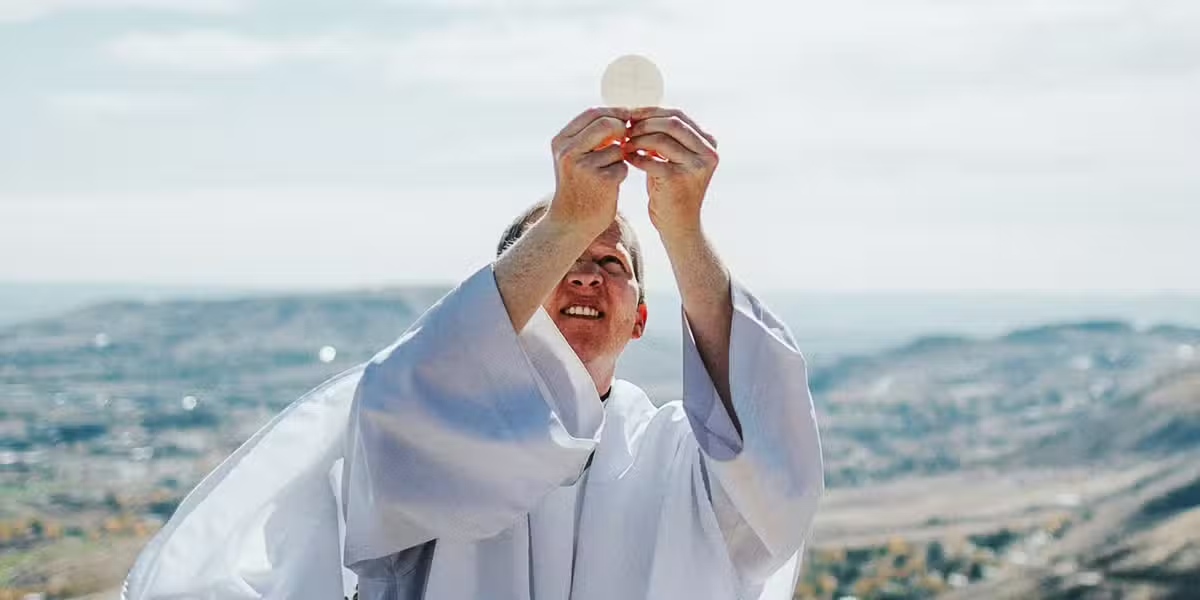A summer Sunday evening on the Lake Shore Limited from New York City to Cleveland. We are passing along the Hudson River at sunset, a red glow on the New Jersey hills across the river as we approach the tip of Manhattan.
I pray for loved ones as I watch the broad Hudson flat and smooth at this hour. Like a hammered bronze shield the river reflects the reddening sky and turns silver as the glow of the setting sun gradually wanes and the gray light of twilight irons out the red tints on the water. We pass Dobs Ferry just as the sun pops up over a low hill for a few seconds, rouging the water as if for a festive celebration. Swiftly we pass Irvington—for Washington Irving? The crests of the hills across the Hudson burn as in an Irving tale. The clouds form fantastic shapes.
Is Sleepy Hollow Cemetery near? I wonder; and just as I’m thinking these thoughts, we pass Tarrytown and, yes, I murmur, here is Ichabod Crane and Rip Van Winkle and the Headless Horseman.
Dark hills now, black with a hint of blue where the remaining twilight breaks through. Idyllic seems an understated word for the magic that light and shadow, red glow and bronzed river turning to silver, and the memory of reading Irving creates. I reach for color, but I have no art with paint and brush. I wish I could reach up to a shelf of Irving works and pull down what his words painted there of black hills and blue as we rush through Ossing, where mallards group like an escutcheon on the burnished shield of a Hudson inlet that will bring us into Croton-Harmon.
How is it I’m mesmerized here, so far from the New Mexico landscape of my youth? And why is this landscape so congenial, so familiar? Isn’t it because it is already inside me in the words of Irving who made this landscape a part of my own interior geography through the enchanting power of words like these from The Legend of Sleepy Hollow?
In the bosom of one of those spacious coves which indent the shore of the Hudson, at the broad expansion of the river denominated by the ancient Dutch navigators as the Tappan Zee, and where they always prudently shortened sail, and implored the protection of Saint Nicholas when they crossed, there lies a small market-town or rural port, which by some is called Greensburgh, but which is more generally and properly known by the name of Tarry Town.
This name was given, we are told, in former days, by the good housewives of the adjacent country, from the inveterate propensity of their husbands to linger about the village tavern on market days.
Once one has fallen under the spell of words like these, reading becomes a transporting inner journey of particular intensity. It’s the way many of us as children began to enter the marvelous world of the imagination. Not that we remember verbatim words like these, but their echoes, their feel, are in us, as they were in me; and on returning home, I looked up the actual words and reread them, imagining again and remembering how they were there in the way I saw the Hudson that summer Sunday evening on the train.
Words like those I’ve quoted here inspire me not only to think and see, but to write, as well. I am moved by them to make my own words, to push words around on the page in order to process with words my own inner and outer landscapes.
Many today keep a journal of their own inner life. They try to make sense of their day by finding words that say how they feel and what’s happening or has happened to bring them to the writing page. But there is more to writing than just saying how you feel and what you think; for to know what you think and feel, it’s often necessary to see what you see and to let the seeing and how you describe it show you what you think and what you feel. In the process your own spiritual autobiography emerges and reveals itself in the images that move you, the specific details that you see within and without.
If you began to write after reading these words, what would you be looking at? What do you see other than your own inner landscape? Do you remember the words of others that have inspired you? What do you look at and feel moved to praise God by? How do words show you what you think and what you feel? How does naming, putting words to your own experiences, lead you to see better what is outside of you? How does seeing help you to enter into the center of the landscape of your soul where you sense the nearness of God?
Spiritual Journeys
There are times when the interior journey is impeded by the refusal or inability to make an external journey. The outward journey may be the move toward another person to seek forgiveness or offer forgiveness; or the journey may be toward some inner place you are afraid to enter or reenter that is closing down your world and keeping you from surrendering to God’s Providence and care. The outer journey is inexplicably entwined with the inner journey and vice versa.
And do I find You again
in words,
did I order them right?
That order,
what does it mean,
why is anything out of order, how?
Words lose their order
in the mind
because the Word
is not received.
It is that receiving
which orders the words that
order the mind that makes
You visible again.
We have failed the first Word
and words without a beginning
are almost-words,
hints of what they are.
Write down the Word,
let it have its place
on the page
and all the words
will fall into sense,
and meaning
will no longer be a search
but a beginning.









3 thoughts on “Journeying toward God”
An excellent insightful read, thank you!
Thank you so much for your thoughtful writing. Traveling along the Hudson is such a joy! Please note that it is Dobbs Ferry and Osssining.
Hi there,
Grace and Peace to you.
Can you kindly make this book available on Kindle.
Many thanks
God Bless
Hayden Smith